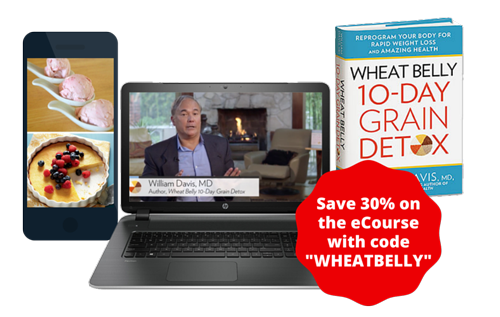William Davis's Blog: Dr. Davis Infinite Health Blog, page 104
June 2, 2016
Doped

I’ll bet you pride yourself on living a pretty clean life.
It’s doubtful that I’d stumble on you in some alley, track marks up your arms, lying in a puddle of your own urine, unconscious from a night of shooting up heroin, snorting coke, or smoking crack. And you probably have all or most of your teeth, unlike the toothless addicts on methamphetamine.
Perhaps you even avoid or minimize your use of the softer recreational drugs in cigarettes and alcoholic beverages. You likely adhere to healthy practices and keep such indulgences to a minimum.
The truth is that you’ve been doping it up for most of your life. You’ve been doping it up with an opiate, not unlike heroin, Oxycontin, or morphine. You’ve been doping it up for breakfast, lunch, dinner, and snacks. No tracks, no toothlessness, no pee stains on your trousers, no cardboard sign reading “I’m homeless and need help” . . . but you’ve still been doping it up.
You’ve been cleverly disguising your opiate of choice as muffins, bagels, breakfast cereals, and sandwiches. As with many of the dark and fascinating hidden issues surrounding modern wheat, this is the effect of the gliadin protein of wheat.
Gliadin is digested via stomach acid and pancreatic enzymes to a collection of polypeptides (small proteins) called exorphins, or exogenously-derived morphine-like compounds. The message to take from the research is clear: Wheat-derived exorphins bind to the opiate receptors of the brain (the delta class of opiate receptors, for you neuroscience people). Different wheat exorphins, such as the A5 fraction, differ in their binding potency, but as a whole, the wheat exorphins exert an opiate-like effect.
For unclear reasons, wheat exorphins do not provide relief from pain, nor the “high” of other opiates. They “only” cause addictive behavior and appetite stimulation. People who consume wheat increase calorie consumption by around 440 calories per day, every day.
Just as the tobacco industry doped their cigarettes for years with added nicotine to increase addictive potential, so Big Food has likewise been doping their foods by adding wheat to every conceivable processed food. Wheat is in nearly all breakfast cereals, granola bars, canned tomato soup, powdered instant soups, taco seasoning, and licorice. Show me a processed food product and I’ll show you something that contains wheat.
Just as the sleazy drug dealer selling you your next hit of crack or heroin profits from your continued addiction, so Big Food acts as your opiate dealer in the wheat exorphin world of addiction. And, just as the drug dealer knows you will be back, else you will suffer withdrawal, sweating, hallucinations, finally begging for your next hit, so Big Food knows you will be back within hours as you begin the exorphin withdrawal process—-tremulous, cranky, and foggy . . . until you get your next hit of a bite of pretzel or bread.
The post Doped appeared first on Dr. William Davis.
May 30, 2016
Chocolate Walnut Ice Cream

Yes, ice cream can fit into your Wheat Belly lifestyle . . . but some adjustments will be necessary.
I have yet to find a commercially produced ice cream or custard that I thought was truly healthy. Even the “no sugar added” ice cream brands are usually sweetened with sorbitol and maltitol that can still cause rises in blood sugar (as well as small LDL particles that lead to heart disease), not to mention gas and diarrhea–-not the best choice after a romantic dinner!
Here’s a way to make your own thick, rich custard without sugar, sorbitol, maltitol, and without having to endure gas and diarrhea. If you have a dairy sensitivity in some form, or if you are among the people whose weight loss is stalled or prevented by dairy products (due to the insulin-provoking action of the whey fraction of protein in dairy products), replace the whipping cream with canned coconut milk. The use of the additional custard step ensures a creamy texture to even coconut milk.
You will need an ice cream maker. I’ve been using an inexpensive one I bought at Target for $23 and the results were great.
Creating the egg yolk custard is key. There are a number of methods to generate the egg yolk-rich custard. I am a fan of simplicity, so I chose the process of making the custard from egg yolks over the stove (that I picked up from Maria Emmerich), followed by blending in the sweetener and the other ingredients. This approach may require a couple of tries to get the temperature and time just right. Even if not perfect, however, the end-product should still be quite edible and delicious. One downside: this ice cream is best consumed right away, as it does not freeze well, becoming icy and hard. You can indeed store in the refrigerator, but will have to wait for it to partially defrost first. This is because we avoid use of emulsifying agents due to their potential to disrupt bowel flora.
The basic recipe can be altered in an unlimited number of ways, e.g., leave out the cocoa and replace with 1 cup mixed fresh or frozen berries, 1 cup wild blueberries, dark chocolate chunks with or without peppermint extract, bing cherries, pistachios, etc.
Makes 4 servings
Ingredients:
4 egg yolks (large or jumbo eggs)
12 ounces (1 1/2 cups) heavy whipping cream, preferably organic, or 1 can coconut milk (13.5 ounces)
Sweetener equivalent to 3/4 cup sugar
1/2 cup unsweetened cocoa powder
1/2 cup chopped walnuts
1/2 teaspoon sea salt
1 teaspoon vanilla extract
Place eggs yolks in small saucepan and heat over low heat. With electric or hand mixer, beat for several minutes until creamy while heating, around 3-4 minutes. Keep heat low enough that yolks do not scramble or coagulate but are warm to touch.
Blend in cream or coconut milk, sweetener, cocoa powder, walnuts, salt, vanilla extract and blend until well-mixed.
Pour entire mixture into ice cream maker and follow manufacturer’s directions. (My device required 25 minutes to convert to thick custard texture.)
The post Chocolate Walnut Ice Cream appeared first on Dr. William Davis.
May 26, 2016
John’s impressive Wheat Belly Detox experience

John shared his Wheat Belly story, starting with the Wheat Belly 10-Day Grain Detox in January:
“Today, I went in to review the results of my blood work. The difference is from December of 2015 to today, after starting my Wheat Belly 10-Day Detox January 19, 2016.
“To start, I am down in weight from 267 lbs to 219. My blood pressure is down from 158/74 to 126/56. Glucose down from 76 to 71. Triglycerides down 287 to 80. Cholesterol down from 215 to 174. HDL Cholesterol up from 36 to 38. LDL Cholesterol down from 122 to 120. Overall, the doctor was very impressed with the overall improvements.
“I’m still sleeping through the night and my psoriasis has improved drastically and almost completely gone. Overall, inflammation pain is down drastically and I am able to walk more than ever before. The process hasn’t been easy, but it sure has been worth it.
“In the process I lost my ‘remote shelf’ (my Wheat Belly) and have to put my remote on the side table now. Below are some before and after pictures. The one on the left is from summer of 2015. The one on the right is summer of 2016. Thank you Dr. William Davis and thanks to PBS. I am a big PBS watcher and supporter and after seeing you on PBS I was hooked and made the commitment to a lifetime of change. Thank you for all you do to change the lives of many. My target weight is 180 lbs and I look forward to reaching my goal. The best is yet to come!”
Down 48 pounds with multiple metabolic improvements in 5 months—not too shabby, especially after rejecting all conventional advice to cut fat and eat more “healthy whole grains.”
And the metabolic numbers are going to improve further over time, since weight loss dampens the improvement of these values. John’s triglycerides have plummeted, but will continue to drop, as they are artificially “propped up” by the ongoing process of weight loss that involves mobilizing fats into the bloodstream as triglycerides (fatty acids); HDL will rise over time, with up to two years required for this slow-responding parameter to show its full potential. I would not be the least bit surprised if John’s eventual HDL cholesterol reaches an impressive, healthy, and longevity-predicting 80, 90, or 100 mg/dl—values often regarded as impossible to achieve, particularly starting as low as 36 mg/dl. (In conventional circles, an HDL of 40 mg/dl is considered good despite being associated with extravagant and uncorrected metabolic distortions that contribute to cardiovascular risk—you should no longer be surprised that conventional advice ensures a future of disease.)
John may have to now reach for his remote, but he has reversed an entire collection of health problems, metabolic distortions, and inflammation, as well as earning envious looks from the people around him who wonder what he does to look so darned good.
The post John’s impressive Wheat Belly Detox experience appeared first on Dr. William Davis.
May 23, 2016
Statin scare

It is shocking that so many people are bullied by doctors into taking statin cholesterol drugs: “The evidence is overwhelming: statins save lives.” “You’re a walking time-bomb. I can’t be responsible for your safety if you don’t take it.” “Your cholesterol is so high that you could die of a heart attack any time.” I’ve even heard of many patients being “fired” by doctors because of a refusal to take the prescription for Lipitor, Zocor, Crestor, or other drug.
Why such strong-arm tactics? Several reasons:
People are given the wrong diet, a diet—reduced in total and saturated fat, increased “healthy whole grains”—that causes inflammation/rise in c-reactive protein (CRP), a drop in HDL (“good”) cholesterol , rise in triglycerides (sometimes dramatic), and an explosion of small LDL particles, all witnessed on the standard cholesterol panel as low HDL, high triglycerides, and higher LDL cholesterol (though under-representing the full magnitude of rise in small LDL particles), as well as higher fasting blood sugar, higher HbA1c, higher blood pressure. These metabolic distortions do indeed increase cardiovascular risk, though not for the reasons most doctors think. This is interpreted by most doctors as reflecting your bad dietary habits and/or the uselessness of diet.
The clinical studies purporting to show 25-50% reduction in cardiovascular risk do nothing of the sort. The real benefit is around 1-3% reduction—measurable but small (and not in all groups of people, with small benefits confined mostly to people who have had a prior cardiovascular event). In other words, doctors perceive around 25-fold more benefit than there truly is. This is because studies (nearly all funded by the drug industry) perform a statistical sleight-of-hand by reporting something called “relative risk’ that misrepresents and exaggerates the real benefit (a topic for future discussion).
They are “treating” either total cholesterol, which is a crude marker of cardiovascular risk in large populations but virtually useless when applied to assessing the risk of an individual, or LDL cholestrol, a calculated—not measured—value. Under the best of circumstances, calculated LDL cholesterol is an unreliable, imprecise marker for cardiovascular risk. Introduce physiological changes such as grain/sugar elimination or fish oil supplementation and dramatic changes develop in the composition of blood lipoproteins (fat-carrying proteins) that make the equation to calculate LDL cholesterol even more unreliable, in fact wildly unreliable. You can witness the unreliability of calculated LDL cholesterol when you perform a superior method of assessing cardiovascular risk, such as an NMR lipoprotein panel. Calculated LDL cholesterol might be, for example, 160 mg/dl—fairly high—but really be only 1000 nmol/L, the equivalent of an LDL value of 100 mg/dl—the calculated value is off by 60%.
Throw on top of this the fact that a third of practicing physicians are self-admitted control freaks and perhaps it should come as no surprise that people are so commonly bullied into statin—and other—prescriptions and medical advice.
Here’s a better way to view statin drugs and the reduction of cardiovascular risk. If you eliminate wheat/grains and sugar, restore vitamin D status, supplement fish oil for omega-3 fatty acids, correct iodine deficiency and obtain ideal thyroid status, restore magnesium, and cultivate healthy bowel flora, i.e., the Wheat Belly Total Health strategies:
Small LDL particles, the most common cause for heart disease, are dramatically reduced or eliminated
HDL cholesterol increases dramatically, rising from, say, a high-risk level of 35 mg/dl, to a healthy level of 70-90 mg/dl over time
Triglycerides plummet. It is not uncommon for a value of 350 mg/dl to drop to 45 mg/dl, an 87% reduction
Total cholesterol drops (though can also rise since HDL rises so much—yet another reason why total cholesterol is worthless: it can go up but reflects the contribution of rising HDL, a good thing)
Blood sugar, HbA1c drop
Blood pressure drops
Inflammation/CRP plummet. CRP levels of zero are typical. (And, no, you do not need high-dose statins to reduce CRP, as some statin manufacturers will argue.)
The basic lipid panel, as well as an advanced lipoprotein panel, are transformed with these lifestyle changes, reflecting reduced cardiovascular risk—without statin drugs.
So the real question with statin drugs becomes: Is there any incremental benefit to statin drugs over and above the benefits achieved with these lifestyle changes that dramatically transform cardiovascular risk markers? If benefit in people following the wrong diet is 1-3%, then it is likely that the benefit to people following the right diet and lifestyle is far less, perhaps zero.
The post Statin scare appeared first on Dr. William Davis.
May 18, 2016
Get MORE with the Next Detox Challenge

The next Wheat Belly 10-Day Grain Detox challenge starts WEDNESDAY, JUNE 1st. Join the thousands of people who are losing weight and regaining health, while having the company and support of others who are going through it with you or have recently completed their own Detox!
To join the Detox Challenge:
Step 1)
Get the book. And read it (at least to chapter 5). Detox Challenge participants should be informed and active in order to get the most out of the Challenge and private Facebook group.
GET EVEN MORE by enrolling in the Detox eCourse, and have all the resources of the Wheat Belly 10-Day Grain Detox at your fingertips, PLUS tons of videos, easy-to-follow recipes, and more! You can get a huge 30% discount with the coupon code DETOX. Click through to try a free sample.
Step 2)
Come join the Private Facebook Group.
http://bit.ly/WheatBelly-PrivateFBGroup
Step 3)
Head back to the Private Facebook Group starting TUESDAY, May 31st and onwards for tips, video, and discussions to help you get through your detox and reprogram your body for rapid weight loss. Dr. Davis will be posting video instructions and answers to all your questions.
The post Get MORE with the Next Detox Challenge appeared first on Dr. William Davis.
May 16, 2016
Some impressive Wheat Belly before/afters
I recently asked the Wheat Belly Facebook audience to provide some before/after photos. Some pretty astounding photos and stories resulted that highlight the inflammation-reversing, age-reversing transformations in appearance with this lifestyle, even more than accounted for by weight loss alone. Here’s a sample.
If you’d like to share your before/after photos or experiences, the best place is on the Facebook page.
Rexene

“Week #46: Lost – 3.2 lbs
“Total lost: 91.8 lbs!!!
“Forty days to make my goal of 100 lbs off in one year… living grain- and sugar-free! (Braving posting first photos! After-photo taken at 88.6 lbs lost.)”
Jennifer:
“Started Wheat Belly August, 2015. This is my latest pic last week. Lots of inches lost, wish I measured!!”

Patty:

Shelly:
“January 2015 and today. 120 pounds and counting.”
Pamela:

Teresa:
“So thankful I’ve found this way of eating!”

Kirk

Adrienne:
“Top-April 1st. Bottom-May 13th. Down 20 pounds.”
Richard:
“46 years old on the left, 50 years old on the right.”

Jenny:
“Left – April 2014. Right – Nov 2014”
Amy:
“After: March 2016 @ 170 lbs. Before: July 2015 @ 205 lbs. I carry in the mid-section and went from a size 20 to a size 12. No more aches and pains, nausea, skin rash and lethargy.”

Tracy:
“2011 on the left, 2016 on the right. 120 lbs gone forever!”
Barbara:
“November 2015 and today.”
Ann:

The post Some impressive Wheat Belly before/afters appeared first on Dr. William Davis.
May 15, 2016
Share Your Journey: Wheat Belly Survey
This survey is designed for people who are not currently following the Wheat Belly lifestyle, although anyone can take it! Please SHARE this survey with friends and family who are interested in losing weight.
Create your own user feedback survey
Thank you so much for participating in this survey! Dr. Davis and his team value your time and your experience.
If you’ve had ENOUGH dieting and want to lose weight while enjoying delicious food and improving your health, join Dr. Davis’s Wheat Belly 10-Day Grain Detox eCourse. You’ll get online access to the information, tools, video instruction, and community support you need to lose weight once and for all.
Exclusive offer: As a THANK YOU to everyone who completed this survey, Rodale University is giving a 30% discount on the eCourse. Just use the discount code WHEATBELLY.
The post Share Your Journey: Wheat Belly Survey appeared first on Dr. William Davis.
Do you need an oil change?
Do you need an oil change? Fats and oils are a huge piece of the Wheat Belly lifestyle—you should be eating plenty of fats each day in order to lose weight and improve your overall health. You can add butter and oil to your salads and vegetables, and choose the fattiest cuts of meat for your meals.
Make sure you’re choosing the right oils!
Choose coconut, palm, extra-virgin olive oil, extra-light olive oil, macadamia, avocado, flaxseed, and walnut oil, as well as organic butter and ghee. Don’t be afraid of saving the oils from bacon, beef, and pork. You can use lard and tallow, provided they are not hydrogenated. Minimize use of polyunsaturated oils (corn, safflower, mixed vegetable, and sunflower). Avoid hydrogenated or partially hydrogenated oils completely.
Special Offer!
If you are ready to jump in to the Wheat Belly lifestyle and want all the instruction, recipes, tools, and resources online at your fingertips, try the Wheat Belly 10-Day Detox eCourse. You can save 30% with the discount code WHEATBELLY.
The post Do you need an oil change? appeared first on Dr. William Davis.
April 27, 2016
Unlucky Charms
 Are there any HEALTHY breakfast cereals?
Are there any HEALTHY breakfast cereals?
Simple answer: No.
Let’s consider the most common ingredients in breakfast cereals: wheat flour, corn, high-fructose corn syrup, sugar. In effect, they therefore contain sugar, sugar, sugar, and sugar. That ain’t good. It explains why the glycemic index of breakfast cereals are all exceptionally high, usually 70 and above. (Sucrose is 59-65, depending on which study you look at.)
How about those coarser cereals with whole grains like oats, millet, buckwheat, etc., such as muesli? Same issues. Followers of the Wheat Belly conversation understand that whole grains are wrongly called “low” glycemic index; they should really be called “less-high” glycemic index. If, for instance, a bowl of sugary cornflakes raises blood sugar from 90 mg/dl to 190 mg/dl, but a bowl of muesli raises blood sugar to 170 mg/dl–it’s not low, just less high. This is true even if there is no added sugar.
The wheat component of cereals, of course, carries all the excess baggage unique to this grain, including appetite stimulation by the gliadin protein via binding to the brain’s opiate receptors, direct small bowel destruction by wheat germ agglutinin, abnormal bowel permeability from gliadin that initiates autoimmune diseases, and unique allergens such as alpha amylase inhibitors and omega-gliadins.
Breakfast cereals are big business. They have come to dominate breakfast (and snacking) habits. They dominate entire supermarket aisles, floor to ceiling, and generate some $11 billion in annual sales. Incredibly, the industry has even managed to persuade the public that breakfast cereals are an essential part of breakfast every day for good nutrition and weight management. They have also co-opted the science demonstrating that fibers from vegetables, fruit, legumes, and nuts can somehow be replaced by the inert bulk of cellulose through bran cereals for bowel health.
Breakfast cereals by definition, in all their various shapes, varieties, flavors, colors, and marketing angles, are all grains with optional sugar. It should therefore come as no surprise that there is no such thing as a healthy breakfast cereal. After all, the whole notion of breakfast cereal originated with William and John Kellogg who, in the late 19th century, operated a sanitarium in Battle Creek, Michigan, where you would stay for a month or two and receive four enemas per day, along with three meals of gruel to “cure” your lumbago, rheumatism, or cancer. One day, while preparing gruel, William was called away, only to return hours later to find his gruel on the table, dry. Being frugal, he wondered if there was a way to salvage it; putting it through a roller, a light bulb of inspiration went off: thus was flaked cereal invented. So the notion of breakfast cereal started with two men who believed that four enemas a day cured cancer.
For anyone missing the crunchiness of a breakfast “cereal” without the health issues, see the Coconut Almond “Granola” recipe here in this blog, the Grainless Granola recipe in the Wheat Belly Cookbook, or the grain-free Classic Granola and Slow Toasted Flakes from Wheat-Free Market. No grains here!
The post Unlucky Charms appeared first on Dr. William Davis.
April 22, 2016
Get MORE with the Next Detox Challenge

The next Wheat Belly 10-Day Grain Detox challenge starts MONDAY, APRIL 25th. Join the thousands of people who are losing weight and regaining health, while having the company and support of others who are going through it with you or have recently completed their own Detox!
To join the Detox Challenge:
Step 1)
Get the book. And read it (at least to chapter 5). Detox Challenge participants should be informed and active in order to get the most out of the Challenge and private Facebook group.
GET EVEN MORE by enrolling in the Detox eCourse, and have all the resources of the Wheat Belly 10-Day Grain Detox at your fingertips, PLUS tons of videos, easy-to-follow recipes, and more! You can get a huge 30% discount with the coupon code DETOX.
Step 2)
Come join the Private Facebook Group.
http://bit.ly/WheatBelly-PrivateFBGroup
Step 3)
Head back to the Private Facebook Group starting SUNDAY, April 24th and onwards for tips, video, and discussions to help you get through your detox and reprogram your body for rapid weight loss. Dr. Davis will be posting video instructions and answers to all your questions.
The post Get MORE with the Next Detox Challenge appeared first on Dr. William Davis.
Dr. Davis Infinite Health Blog
Recognize that this i The insights and strategies you can learn about in Dr. Davis' Infinite Health Blog are those that you can put to work to regain magnificent health, slenderness, and youthfulness.
Recognize that this is NOT what your doctor or the healthcare system provides, as they are mostly interested in dispensing pharmaceuticals and procedures to generate revenues. The healthcare INDUSTRY is not concerned with health--you must therefore take the reins yourself.
Dr. Davis focuses on:
--Real, powerful nutritional strategies
--Addresing nutrient deficiencies unique to modern lifestyles
--Deep insights into rebuilding the microbiome disrupted by so many modern factors
Follow Dr. Davis here and on social media and you can witness the extraordinary successes people enjoy on his programs. ...more
- William Davis's profile
- 160 followers





